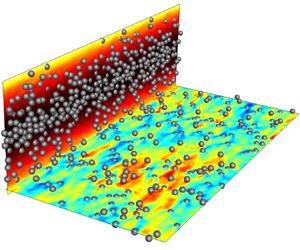Article contents
Viscoelasticity and the dynamics of concentrated particle suspension in channel flow
Published online by Cambridge University Press: 27 August 2020
Abstract

The interplay of particles and viscoelasticity in turbulent channel flow is studied using direct numerical simulations. The particle concentration is moderate at 20 % solid volume fraction, and the range of fluid elasticity spans from zero for Newtonian fluid to high Weissenberg numbers,  $Wi = 25$. Qualitative changes in the flow dynamics are observed compared with dilute suspensions which were studied previously and are known to promote the cycles of hibernating and active turbulence. In contrast, at moderate concentration of particles, these cycles are entirely absent at the same level of fluid elasticity. In addition, instead of the commonly anticipated polymer drag reduction, a drag increase is observed when elasticity exceeds a threshold Weissenberg number. The higher drag is examined at various scales, starting from a global stress balance and down to the level of the particle microstructure. A key factor is the increase in polymer stresses, while the Reynolds shear stress is nearly eradicated. An explanation is provided by analysing the polymer conformation tensor using appropriate measures of its departure from the equilibrium state, with particular focus on the fluid in the vicinity of the particles. It is also demonstrated that viscoelasticity markedly affects both the diffusion and migration dynamics of the particles: diffusion is inhibited due to suppression of turbulent activity and, as a result, reduced mixing of particles and faster decorrelation of their motion; migration is preferential towards the channel centre, which leads to appreciable clustering in that region, which has a direct impact on the local polymer stresses.
$Wi = 25$. Qualitative changes in the flow dynamics are observed compared with dilute suspensions which were studied previously and are known to promote the cycles of hibernating and active turbulence. In contrast, at moderate concentration of particles, these cycles are entirely absent at the same level of fluid elasticity. In addition, instead of the commonly anticipated polymer drag reduction, a drag increase is observed when elasticity exceeds a threshold Weissenberg number. The higher drag is examined at various scales, starting from a global stress balance and down to the level of the particle microstructure. A key factor is the increase in polymer stresses, while the Reynolds shear stress is nearly eradicated. An explanation is provided by analysing the polymer conformation tensor using appropriate measures of its departure from the equilibrium state, with particular focus on the fluid in the vicinity of the particles. It is also demonstrated that viscoelasticity markedly affects both the diffusion and migration dynamics of the particles: diffusion is inhibited due to suppression of turbulent activity and, as a result, reduced mixing of particles and faster decorrelation of their motion; migration is preferential towards the channel centre, which leads to appreciable clustering in that region, which has a direct impact on the local polymer stresses.
Information
- Type
- JFM Papers
- Information
- Copyright
- © The Author(s), 2020. Published by Cambridge University Press
References
REFERENCES
- 9
- Cited by


